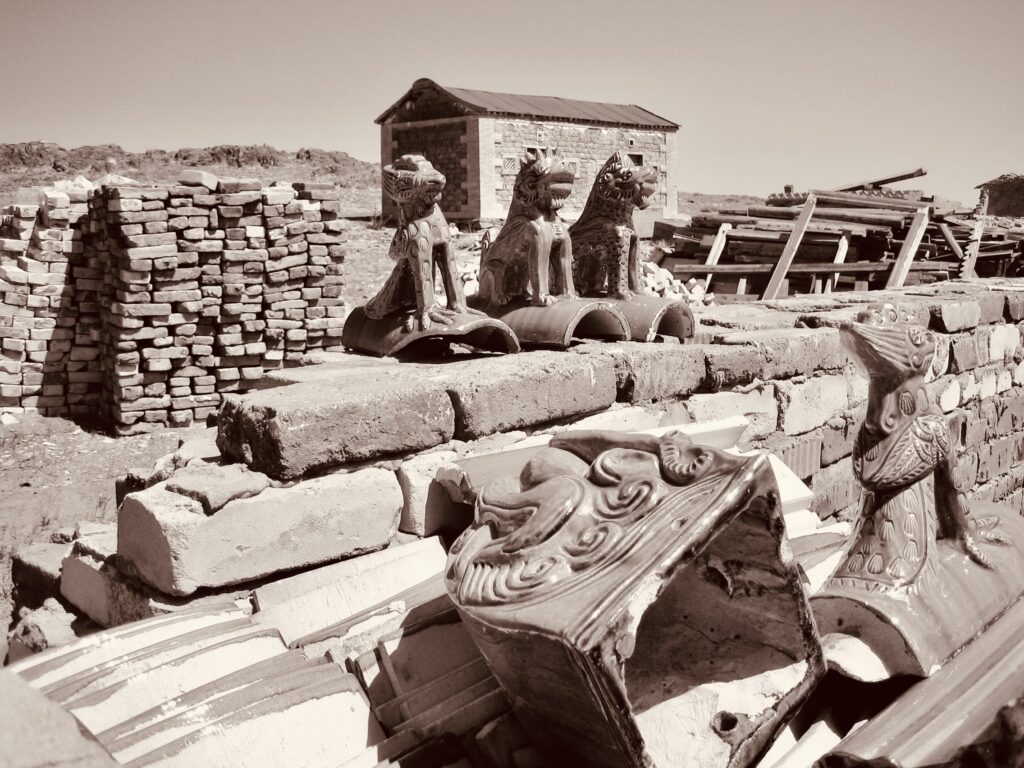In this short essay, I outline why I consider noticing the contribution of Mongolian women involved in revitalising their own spiritual tradition and its practices is important.

The early days. Stacks of the some of the building materials used for the successful Soyombot Oron-Delgeruun Choira Reconstruction Project in the Gobi Desert, Mongolia. 15 July 2005. Photograph: C.Pleteshner
During fieldwork in Mongolia since 2004, it has been my observation that contemporary gelug lamas working in Mongolia vary enormously in the degree to which they express publicly their own position on gender relations in the social and cultural spheres in which they have influence.
Gender is relational, especially when considered with reference to social and cultural differences rather than biological ones. It requires at least two people for roles and their power-relations to be enacted. Hence, the gender relations performed on any one occasion will not only depend on the two people engaged in the interpersonal transaction, but will also be influenced by a whole raft of other considerations, such as who else is there, the forum, etcetera. I suspect that a gelug lama’s power-relations position, like that of most of us, would shift to accommodate the sensibilities of the other person, their own interests, the audience and the particular context within which a particular social transaction is being performed.
The truth is I have a deep respect and affection for the gelug lamas and lams in Mongolia with whom I am associated. I have never lost sight of the fact that these same people, as individuals, and as spiritual leaders within their own organisations, have considerable, serious and important responsibilities and concerns of their own.
Mongolian gelug lamas (prelates) and lams (monks) also have family members who play a vital role in supporting any enterprise with which their lama is associated. Nowhere is this more evident than in the socio-cultural space we refer to as Mongolia. Here, the efforts of family and other members of their extended community support, compliment and merge with that of their chosen Mongolian gelug teacher and his lams in a variety of very particular ways. In this context previously gendered roles and relations coalesce.
It is precisely this interwoven complex of familial roles and social relations that underpins the success (or otherwise) of a gelug buddhist revivalist project in Mongolia. Here, I am referring to those that are taking shape outside of the precincts and institutions such as Ganden Monastery in Ulaanbaatar.
On this topic I am no expert, but I suspect that the patron-priest relationships (a western academic descriptor) formed through and around high profile politico-religious institutions such as Ganden, differ markedly from those of extended family-based enterprises such as the successful Soyombot Oron-Delgeruun Choira Reconstruction Project in the Gobi Desert, and other datsans that are local for proximal relations and on a smaller scale.
For the Mongolian people with whom I keep good company, revitalising their Buddhism as a lived practice has involved so much more than finding (or being) rich patrons who sponsor buildings and statues. There has always been a constant stream of other much less visible (to outsiders) generosities being offered and performed.
Since 2004 I have also noticed how two generations of Mongolian women’s contribution to nourishing the fabric of their Mongolian society and its compassion-towards-others spiritual beliefs has been swept away. Of course, there are many reasons for such change, but the tide of others from abroad sweeping into Mongolia in pursuit of their own or their organisation’s global integration conceptions of material, academic and/or spiritual gold, are surely playing a profoundly catalytic role?
If we are not careful, all that will remain of these women’s considerable community-based legacies, will be individual collections of soviet-style medals packed away in the family’s special commode, to be brought out on occasion for a photo-shoot or two. If we are not mindful now, nothing will be salvaged as testimony to these women’s inherited, transmitted, cherished, salvaged, Mongolian, Buddhist past. For my part, I would prefer that their courage and tenacity-of-endeavour does not go unnoticed.
________________________
Attribution
This Letter from Mongolia like others in this series, is grounded in my ethnographic fieldwork (2004- ) and interviews with the people about whom I write. All of the people in this assemblage are Khalkha Mongol, the largest group of ethnic Mongol peoples living in Mongolia today. See: Pleteshner, C. (2011). Nomadic Temple: Daughters of Tsongkhapa in Mongolia (Unpublished manuscript). The Zava Damdin Sutra and Scripture Institute Library Archive in the Manjushri Temple, Soyombot Oron). pp86-87
In keeping with ethical scholarly research and publishing practices and the Creative Commons Attribution 4.0 International License, I anticipate that anyone replicating the photographs, using or translating into another language all or part of this article and submitting it for accreditation or other purpose under their own name, to acknowledge this URL and its author as the source. Not to do so, is contrary to the ethical principles of the Creative Commons license as it applies to the public domain.
end of transcript.
Please refer to the INDEX for other articles that may be of interest.
© 2013-2025. CP in Mongolia. This post is licensed under the Creative Commons Attribution 4.0 International License. Documents linked from this page may be subject to other restrictions. Posted: 18 April 2024. Last updated: 18 April 2024.